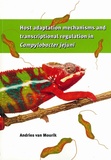Host adaptation mechanisms and transcriptional regulation in Campylobacter jejuni

Mourik, Andries van
- Promoter:
- Prof.dr. J.P.M. (Jos) van Putten
- Co-promoter:
- Dr M.M.S.M. (Marc) Wösten
- Research group:
- Putten
- Date:
- February 22, 2011
- Time:
- 14:30 h
Summary
Campylobacter jejuni is the most common cause of bacterial foodborne illness causing >100 million human cases each year worldwide. In contrast to other important enteropathogens such as Salmonella and Shigella spp., C. jejuni appears to lack a set of classical virulence traits, like adhesins, type III secretion system and toxins. Nevertheless the bacterium is equipped with a large repertoire of adaptation skills that influence bacterial surface properties, metabolism and behavior. These adaptation skills may contribute to bacterial virulence by enabling the bacteria to rapidly alter their phenotype and metabolism in response to changes in the environment. The major goal of the work described in this thesis was to gain insight in essential steps in the adaptation of C. jejuni and to assess the effects of variation in bacterial phenotype on survival and immunity. The results described in this thesis contribute to the understanding of the infection process by providing novel molecular and cellular insights in the C. jejuni repertoire of environmental adaptation. We characterized a functional C. jejuni Tat secretion machinery, which is necessary for the transport of different proteins essential for adaptation to nutrient and oxygen limited conditions and to colonize chickens. Additional studies revealed that a C. jejuni tatC mutant is defective in different virulence related strategies. This might indicate that environmental adaptation via the Tat system plays a fundamental role in Campylobacter virulence. Next we described the existence of two novel complementary lipid A modifying enzymes. We obtained evidence that these enzymes determine the ratio between N- and O-linked fatty acyl chains in the lipid A part. This ratio influences the resistance to antimicrobial peptides as well as the ability to activate the pro-inflammatory TLR4/MD-2 innate immune pathway. The lipid A modification may thus enhance the immune evasive properties of the organism. Analysis of the function of two-component systems as regulators of bacterial metabolic adaptation revealed a role for the RacS-RacR two-component regulatory system. First we discovered that the conformation of the RacS sensor protein, and thereby the activity of the RacS-RacR system, is dependent on a functional C. jejuni Dsb system. In addition evidence was obtained that this two-component system regulates metabolic processes during conditions of oxygen limitation. These results showed that the RacS-RacR system fine-tunes the metabolic pathways of C. jejuni so that it can survive and quickly respond to changes in nutrient and oxygen availability. These changes likely occur in the gastrointestinal tract of humans and chicken and might be central for C. jejuni virulence. Our results add novel knowledge on bacterial adaptation and survival mechanisms which may provide an important basis for novel strategies as to how to reduce the presence of C. jejuni and thus contribute to food safety and human health.